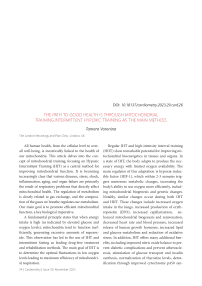The path to good health is through mitochondrial training intermittent hypoxic training as the main method
Автор: Voronina Tamara
Журнал: Cardiometry @cardiometry
Рубрика: Conference proceedings
Статья в выпуске: 29, 2023 года.
Бесплатный доступ
All human health, from the cellular level to overall well-being, is inextricably linked to the health of our mitochondria. This article delves into the concept of mitochondrial training, focusing on Hypoxic Intermittent Training (HIT) as a central method for improving mitochondrial function. It is becoming increasingly clear that various diseases, stress, shock, inflammation, aging, and organ failure are primarily the result of respiratory problems that directly affect mitochondrial health. The regulation of metabolism is closely related to gas exchange, and the composition of the gases we breathe regulates our metabolism. Our main goal is to promote efficient mitochondrial function, a key biological imperative
Iht, carbon dioxide, mitochondria
Короткий адрес: https://sciup.org/148327398
IDR: 148327398 | DOI: 10.18137/cardiometry.2023.29.conf.26
Текст статьи The path to good health is through mitochondrial training intermittent hypoxic training as the main method
The London Neurology and Pain Clinic, London, UK
All human health, from the cellular level to overall well-being, is inextricably linked to the health of our mitochondria. This article delves into the concept of mitochondrial training, focusing on Hypoxic Intermittent Training (HIT) as a central method for improving mitochondrial function. It is becoming increasingly clear that various diseases, stress, shock, inflammation, aging, and organ failure are primarily the result of respiratory problems that directly affect mitochondrial health. The regulation of metabolism is closely related to gas exchange, and the composition of the gases we breathe regulates our metabolism. Our main goal is to promote efficient mitochondrial function, a key biological imperative.
A fundamental principle states that when energy intake is high (as indicated by elevated glucose and oxygen levels), mitochondria tend to function inefficiently, generating excessive amounts of superoxide. This observation has led to the use of IHT and intermittent fasting as leading drug-free treatment and rehabilitation methods. The main goal of IHT is to determine the optimal fluctuations in low oxygen levels leading to maximum efficiency of mitochondrial respiration.
34 | Cardiometry | Issue 29. November 2023
Regular IHT and high-intensity interval training (HIIT) show remarkable potential for improving mitochondrial bioenergetics in tissues and organs. In a state of IHT, the body adapts to produce the necessary energy with limited oxygen availability. The main regulator of this adaptation is hypoxia-inducible factor (HIF-1), which within 2-3 minutes triggers numerous metabolic changes, increasing the body’s ability to use oxygen more efficiently, including mitochondrial biogenesis and genetic changes. Notably, similar changes occur during both IHT and HIIT. These changes include increased oxygen intake in the lungs, increased production of erythropoietin (EPO), increased capillarisation, enhanced mitochondrial biogenesis and rejuvenation, decreased heart rate and blood pressure, increased release of human growth hormone, increased lipid and glucose metabolism and reduction of oxidative stress. In addition, IHT offers many additional benefits, including improved nitric oxide balance to prevent diabetic complications and prevent atherosclerosis, stimulation of glucose transport and insulin synthesis, normalization of thyroxine levels, detoxification through improved cytochrome p450 syn- thesis, and improved mood through dopamine balance and serotonin, as well as improved sleep quality. An important difference and advantage of IHT over HIIT is the quick and effective removal of excess lactic acid during sessions/trainings. Lactic acid removal creates an optimal gas exchange environment for mitochondria, including maintaining pH balance, carbon dioxide and nitric ox- ide levels. Essentially, through controlled fluctuations in the level of inhaled oxygen, we tune the mitochondria’s ability to operate at peak efficiency, much like achieving resonance in music. Our goal is to compare these two methods and show unique possibility of using HIIT and IHT together and their application in patients with various pathologies, athletes and non-athletes.


